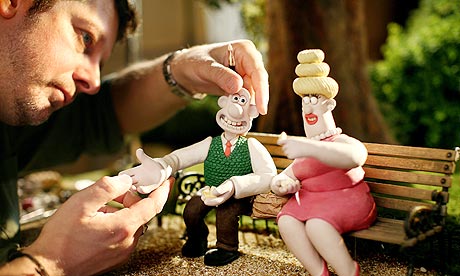Research on Stop Motion:
Stop Motion describes the process of making a sequence of pictures play in order at a speed which creates the illusion of movement. This is generally achievable by taking many photos of an object, though moving it slightly in between each photo - creating an Animation.
There are many examples of Stop- Motion Animation and the most famous would be 'Wallace and Gromit'. All of the characters in Wallace and Gromit are made out of plasticine and are therefore able to move as freely as possible. For every photo taken the parts of the character are moved slightly. These individual photos are known as 'Stop Frames'. After the shooting, these Stop-Frames are all played quickly to create movement and thus an Animated cartoon.
The Persistence of Vision with Stop Motion:
Stop Motion takes advantage of most human senses. If an object moves too quickly, the human eye will not process it straightaway, leaving a slight after image for roughly one twenty-fifth of a second.
An early example of this would be Edward Muybridge's 'Running Horse' animation.
The Pioneers of 3D Stop Motion:
The conception of Stop Motion can be credited to a few notable names, some of which were known primarily for other parts of filmmaking. Thomas Edison, for example is known for inventing the light-bulb, however he is also known for Stop-Motion productions such as 'Fun in a Bakery Shop'.
This technique can be tracked as far back as the 1800's, when film itself was beginning to see the light of day.
Edward J. Muybridge
Edward Muybridge was arguably one of the most important pioneers of 3D Stop motion, he was an English photographer of the 1800's and best known in the Stop Motion industry for his 'running horse' animation.
The initial goal was to prove the theory that a horse is airborne at least briefly during a gallop, which he accomplished in 1877 after successfully photographing a point in the horse's motion. Muybridge further proved his theory by taking several pictures of a horse running, placing them one after another and this created a moving image of a horse's gallop. The animation demonstrated exactly which point the gallop the horse is airborne, though this is the least of the industry's interests.
Muybridge hadcreated an animation of a running horse by simply using photographs,and arguably oneof the earliest forms of animation; an effort which can still be appreciated by today’sstandards.However, it is worth noting that this animation was not neccesarily ‘animated’ at the timeof it’s creation, but rather each frame of the animation was created. It’s thanks to anotherpioneer of the 1800s that such motion could be created…
Tim Burton
Tim Burton has to be one of my most favourite directors and Animators. He is an esteemed director and has created two animated 3D stop Motion feature films - 'The Nightmare Before Christmas' and 'The Corpse Bride', the former of which is frequently looked back upon as a masterpiece in animation, and holds a vast cult following for it's unique style and memorable characters.
'Lanka' is also known to have produced the feature length film 'Coraline' with several key production members from Tim Burton's 'The Nightmare Before Christmas'. Despite being somewhat overshadowed by CGI Animation, the stop motion industry still manages to strive down to the unique and hardworking Animators who produce such aesthetically pleasing frame-by-frame Animations.




No comments:
Post a Comment